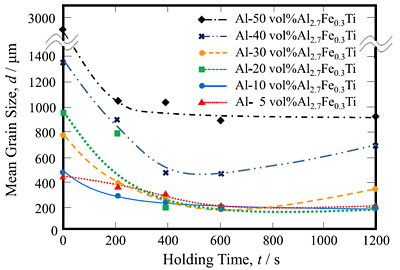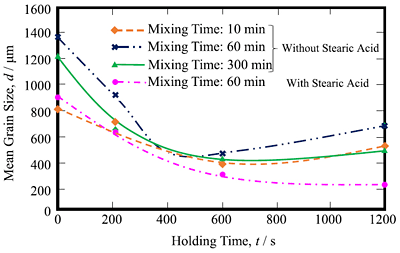In our previous studies, it has been shown that L12 modified (Al1-xMex)3Ti intermetallic compounds show good grain refining performance, although L12 modified (Al1-xMex)3Ti intermetallic compounds cannot coexist with Al matrix in an equilibrium state. Al-10vol%Al2.7Fe0.3Ti and Al-10vol%Al2.7Ni0.3Ti refiners with small M value, which is approximately proportional to the specific misfit strain energy, are successfully fabricated by spark plasma sintering (SPS). This is because SPS can be carried out at a low temperature with short heating, holding, and cooling times, which can be achieved in a non-equilibrium state. The grain refining performance of refiner could be also improved by decreasing the size of heterogeneous nucleation site particles and increasing in the number density of nucleation sites by using severe plastic deformation (SPD) technique. It is also found that cold rolled Al-Al3Ti refiner shows enhanced grain refining performance. If the refiner has double number of heterogeneous nucleation site particles, half amount of addition could show the same grain refining performance. This will result in the reducing of refiner cost of manufacturing. Recently grain refining performance of the refiners with high volume fraction of Al2.5Cu0.5Ti heterogeneous nucleation site particles up to 40vol% was studied. In the present study, refiners with high volume fraction of Al2.7Fe0.3Ti heterogeneous nucleation site particles were, therefore, fabricated by SPS from mixed-powder of Al particles and Al2.7Fe0.3Ti particles, to reduce the addition level of refiners into molten Al. Grain refining performance was, then, studied using fabricated refiners. Especially, mixing conditions of mixed-powder are focus to study the distribution of Al2.7Fe0.3Ti particles in refiner on grain refinement performance.
Figure 1 show the average grain size of Al casts refined with the Al-Al2.7Fe0.3Ti refiners plotted against the holding time. The refiners containing different amounts of heterogeneous nucleation site particles showed differences in the grain refining performance with the holding time, even though the total amount of Al2.7Fe0.3Ti heterogeneous nucleation site particles within the melt was the same. Although the Al-5vol%Al2.7Fe0.3Ti, Al-10vol%Al2.7Fe0.3Ti, Al-20vol%Al2.7Fe0.3Ti, and Al-30vol%Al2.7Fe0.3Ti refiners show similar grain refining performance, reduced grain refinement performance of refiners with high volume fraction of heterogeneous nucleation site particles was found. The finest grain size of casts refined by Al-5vol%Al2.7Fe0.3Ti, Al-10vol%Al2.7Fe0.3Ti, Al-20vol%Al2.7Fe0.3Ti, Al-30vol%Al2.7Fe0.3Ti, Al-40vol%Al2.7Fe0.3Ti, and Al-50vol%Al2.7Fe0.3Ti refiners are 227 µm, 218 µm, 211 µm, 178 µm, 512 µm, and 929 µm, respectively. In case of Al-40vol%Al2.7Fe0.3Ti refiner, the same amount of heterogeneous nucleation site particles can be added even if the addition amount of the grain refiner is one fourth of Al-10vol%Al2.7Fe0.3Ti refiner. This will result in the reducing of cost of manufacturing. However, since pores and aggregated particles were existed in the Al-40vol%Al2.7Fe0.3Ti refiner, reduced grain refinement performance was found. It is expected that the grain refining performance could be enhanced by decreasing such pores and aggregated particles.
To improve their grain refining performance, the effects of mixing conditions on microstructure of Al-40vol%Al2.7Fe0.3Ti refiners were studied. The mixing time was varied (10 min, 60 min, and 300 min) to examine the distribution of Al2.7Fe0.3Ti particles in refiner on grain refinement performance. The effect of addition of stearic acid (CH3(CH2)16COOH) on the spatial distribution of Al2.7Fe0.3Ti particles in refiner is also studied, where mixing time was 60 min. A defect analysis was carried out on the X-ray computer tomography (CT) scan of the refiners. The 3D image made semi-transparent to view the location, shape and sizes of the defects are shown in Fig. 2, where the largest voids are colored in red, while the smallest in blue. It is seen that large pores with a size of 0.35 mm3 can be observed in the refiner fabricated without the stearic acid, while such large pore cannot be found in the refiner fabricated with the stearic acid. Moreover, only smaller amount of pores are observed in the refiner fabricated with the stearic acid. Therefore, it is concluded that the refiner with high volume fraction of uniformly dispersed Al2.7Fe0.3Ti heterogeneous nucleation site particles without larger pores can be fabricated by addition of the stearic acid during the preparation of mixing of Al particles and Al2.7Fe0.3Ti particles.
It is expected that the grain refiner with uniform distribution of heterogeneous nucleation site particles and without larger pores (refiner fabricated with the stearic acid) should show better grain refining performance comparing with those containing aggregated heterogeneous nucleation site particles and larger pores (refiners fabricated without the stearic acid). The average grain size of each Al cast is evaluated and results are plotted against the holding time, as shown in Fig. 3. The minimum grain sizes of Al casts refined by these refiners were 401 µm, 512 µm, 448 µm, and 298 µm, respectively. Acceptable grain refining performance is, now, appeared in the refiner with high volume fraction of heterogeneous nucleation site particles by addition of stearic acid during preparation of mixed powder. Here, considering about effects of the addition of stearic acid into the grain refiner on its grain refining performance, it is seen from Fig. 3 that the grain refiner with stearic acid has better grain refinement ability than the grain refiner without stearic acid. Now we would like to discuss why the grain refiner fabricated with stearic acid shows better grain refinement ability. One reason is homogeneously distribution of heterogeneous nucleation site particles. Spatial distribution of heterogeneous nucleation site particles in the grain refiner is homogenized by the addition of the stearic acid. Since the nucleation during solidification start on heterogeneous nucleation site particles, it is natural that grain refiner with homogeneously distribution of heterogeneous nucleation site particles have better grain refinement ability. Another reason may be the influence of pore and density of the refiners, which could be decreased and increased by addition of the stearic acid, respectively. If a heterogeneous nucleation site particle touches with gas phase, the classical nucleation theory does not hold. To act as heterogeneous nucleation site, the Al2.7Fe0.3Ti particles must be surrounded by molten Al. Although the SPS was carried out under vacuum condition, some retained gas may exist within the pores, which prohibit the grain refining ability. Moreover, the refiners with smaller density tend to buoy up in the molten Al, even though the density of Al-40vol%Al2.7Fe0.3Ti refiner is larger than that of molten Al. Buoyed up refiner becomes a kind of dross, and the Al2.7Fe0.3Ti particles in the refiner do not act as heterogeneous nucleation site. On the other hand, since the refiner with full density does not buoy up in the molten Al, the Al2.7Fe0.3Ti particles spread into the molten Al effectively, which results in the better grain refining performance. In this way, reducing the pores and aggregation of heterogeneous nucleation site particles, one can obtain an acceptable refiner with high volume fraction of heterogeneous nucleation site particles.


